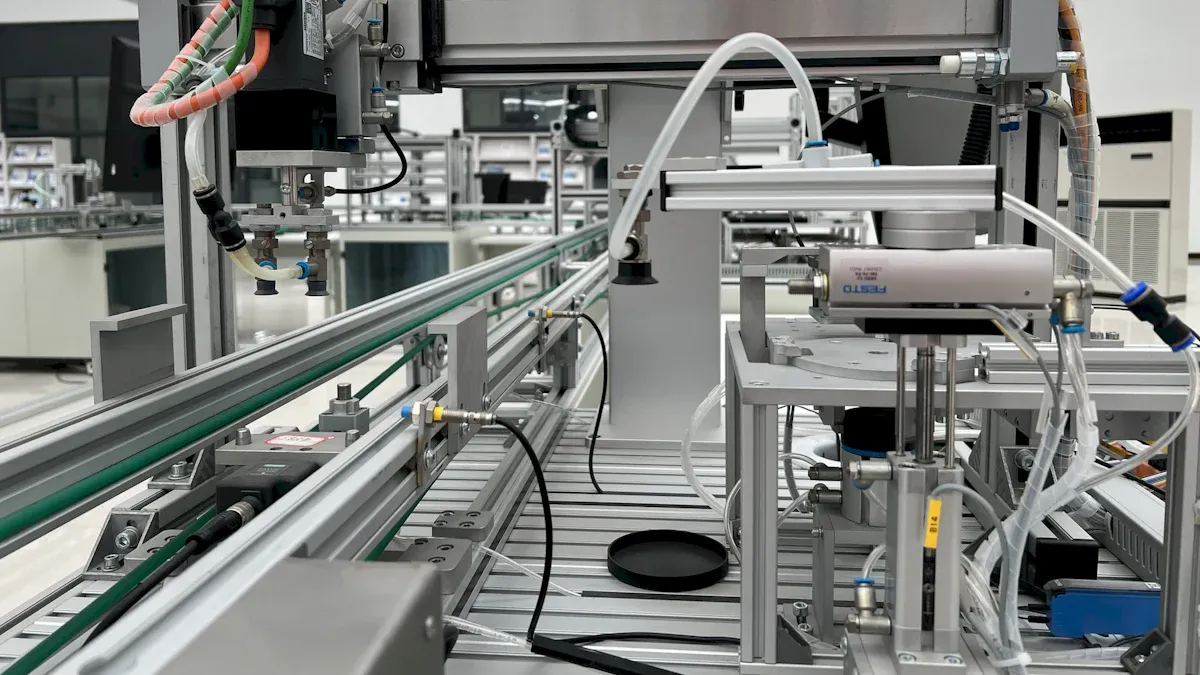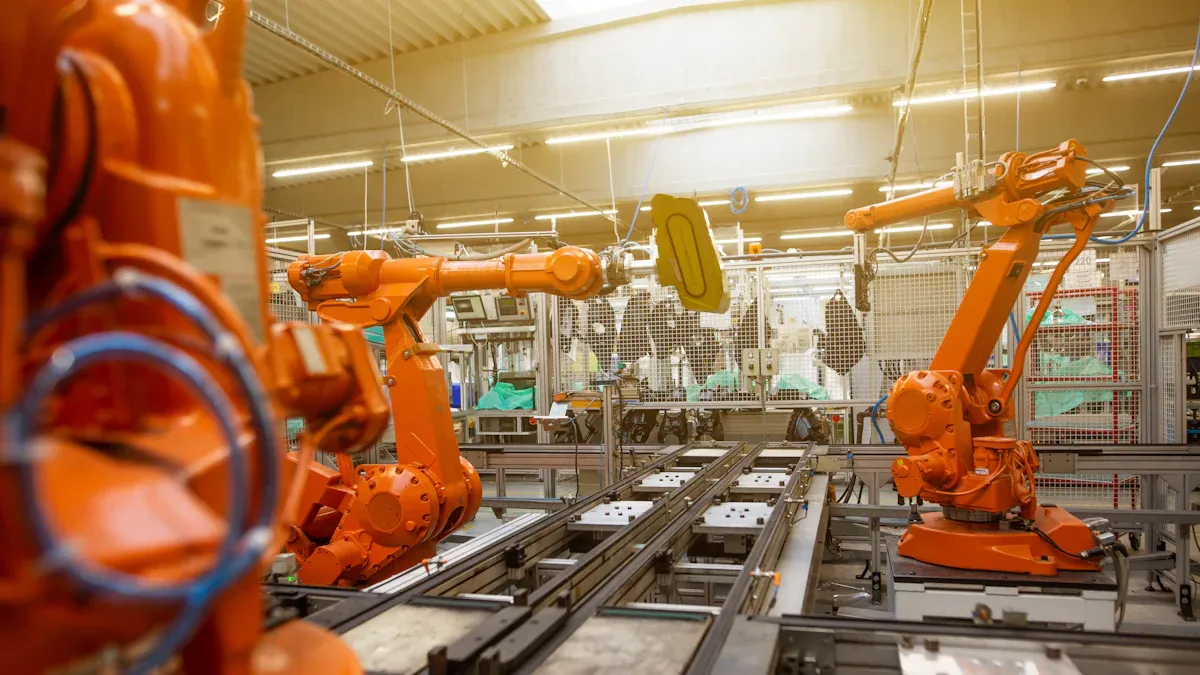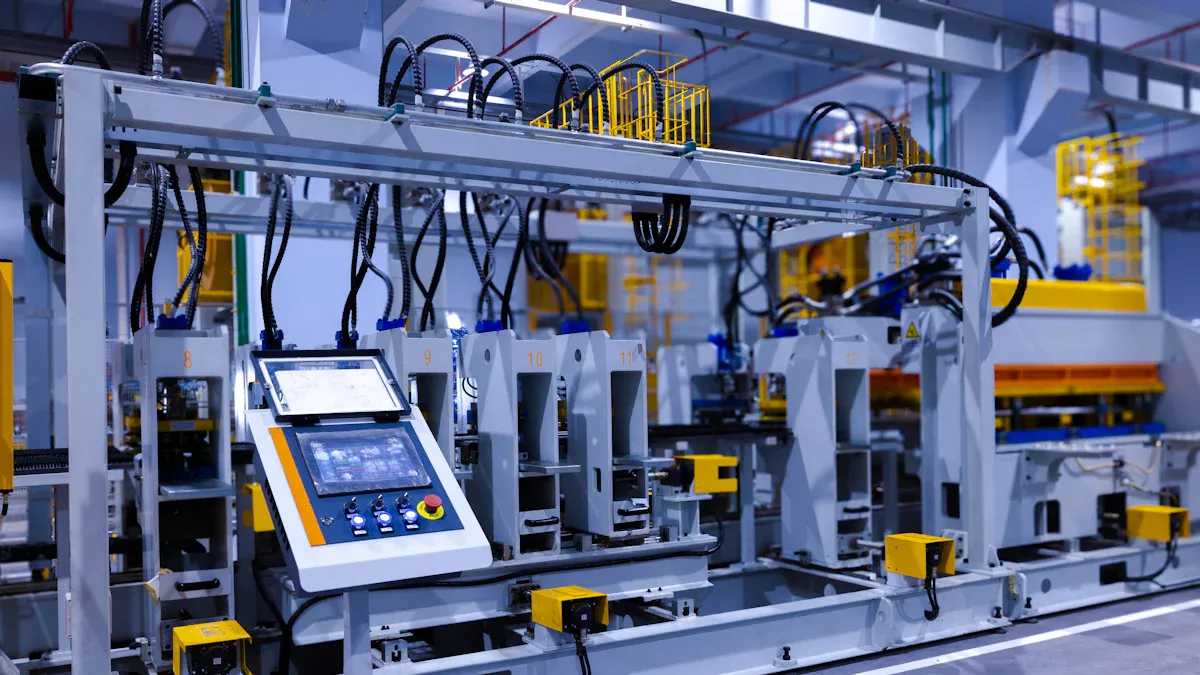
Das Jahr 2025 markiert eine entscheidende Transformation in der Vertragsherstellung. Technologische Innovation ist die Umgestaltung von Produktionsprozessen, mit 74% von Herstellern, die bereits generative KI verwenden, um Kundenerlebnisse zu verbessern. Nachhaltigkeit wird zu einer Priorität, Da die Industrien saubere Energielösungen anwenden und an Trends wie reduzierten Emissionen ausgerichtet sind. Zum Beispiel, Eine strategische Allianz lieferte kürzlich einen Prototyp Electric Mining Truck, Die Grenzen der umweltfreundlichen Fertigung überschreiten. Kooperative Partnerschaften spielen auch eine entscheidende Rolle, Förderung der gemeinsamen Innovation und Transparenz. Diese Änderungen treiben die Effizienz vor, Beweglichkeit, und Umweltverantwortung, Setzen Sie neue Standards für die Zukunft der Fertigung.
Technologische Fortschritte bei der Vertragsherstellung

Die Landschaft der Vertragsherstellung wird in einer signifikanten Transformation in erfahren 2025, Angetrieben von fortschrittlichen Fertigungstechnologien. Diese Innovationen verändern die Art und Weise, wie Produkte entwickelt werden, produziert, und geliefert. Durch die Annahme der digitalen Transformation, Sie können neue Effizienzniveaus freischalten, Präzision, und Skalierbarkeit in Ihren Operationen. Erforschen wir drei wichtige technologische Fortschritte, die die Zukunft von Vertragsherstellungsorganisationen prägen (CDMOs).
Automatisierung und Robotik
Automatisierung und Robotik revolutionieren die Herstellungsprozesse. Smart Factories verlassen sich jetzt auf automatisierte Systeme, um sich wiederholende Aufgaben mit unübertroffener Geschwindigkeit und Genauigkeit zu erledigen. Mit Sensoren und KI -Funktionen ausgestattete Roboter können komplexe Vorgänge ausführen, Reduzierung des menschlichen Fehlers und Steigerung der Produktivität. Zum Beispiel, Ein Vertragselektronikhersteller meldete a 22% Zunahme des Herstellungsdurchsatzes und a 37% Verringerung der Vorlaufzeit der Produktion nach der Implementierung der Automatisierung.
Sie können auch von der Automatisierung profitieren, indem Sie das Bestandsverwaltung optimieren und die Einhaltung des Zeitplans verbessern. Laut Branchenberichten, Die Automatisierung hat zu messbaren Verbesserungen geführt, wie a 20-30% Reduzierung des Inventars und a 15-30% Steigern Sie die Einhaltung des Zeitplans. Diese Fortschritte verbessern nicht nur die betriebliche Effizienz, sondern ermöglichen es Ihnen auch, sich auf Innovation und Kundenzufriedenheit zu konzentrieren.
Künstliche Intelligenz und maschinelles Lernen
Künstliche Intelligenz (Ai) und maschinelles Lernen (Ml) befähigen CDMOs, intelligentere Entscheidungen zu treffen. Diese Technologien analysieren große Datenmengen, um Muster zu identifizieren, Ergebnisse vorhersagen, und Prozesse optimieren. Durch die Integration von KI in Ihren Fertigungsbetrieb, Sie können die Qualitätskontrolle verbessern, Abfall reduzieren, und die Produktionsplanung verbessern.
KI-gesteuerte Systeme können auch die Leistung der Geräte in Echtzeit überwachen, kostspielige Ausfallzeiten verhindern. Zum Beispiel, Vorhersagungswartungswartung durch ML -Algorithmen sorgt dafür, dass Maschinen mit Spitzeneffizienz arbeiten. Dieser proaktive Ansatz minimiert Störungen und erweitert die Lebensdauer Ihrer Ausrüstung. Infolge, Sie können eine höhere Arbeitsproduktivität und bessere Ergebnisse erzielen, mit einigen Herstellern melden a 15-40% Verbesserung der Produktqualität.
Digitale Zwillinge und virtuelle Prototypen
Digitale Zwillinge und virtuelle Prototypen transformieren die Entwicklung und getestete Produkte. Ein digitaler Zwilling ist eine virtuelle Nachbildung eines physischen Produkts oder eines Prozesses, Ermöglichen Sie, dass Sie Entwürfe simulieren und optimieren, bevor die Produktion beginnt. Mit dieser Technologie können Sie potenzielle Probleme frühzeitig identifizieren, Zeit und Ressourcen sparen.
Zum Beispiel, Altum RF verwendete digitale Zwillingsechnologie zu Reduzieren Sie seinen Entwurfsprozess durch 30%. Durch die Behandlung von Designfehler in der virtuellen Bühne, Das Unternehmen optimierte die Produktleistung und beschleunigte Zeit-to-Market. Echtzeit-Sichtbarkeit in Projektmetriken ermöglichte auch eine schnellere Entscheidungsfindung, Sicherstellen, dass die Stakeholder während des gesamten Entwicklungsprozesses ausgerichtet waren.
Virtuelle Prototyping ergänzt digitale Zwillinge, indem Sie mehrere Design -Iterationen testen können, ohne physikalische Prototypen zu erstellen. Dieser Ansatz reduziert nicht nur die Kosten, sondern unterstützt auch nachhaltige Fertigungspraktiken, indem sie Materialabfälle minimieren. Durch die Nutzung dieser hochmodernen Fertigungstechnologien, Sie können in einem wettbewerbsfähigen Markt weiterentwickeln.
Nachhaltigkeit als Kernfokus bei der Herstellung

Nachhaltigkeit ist in der Herstellung nicht mehr optional. Es ist zu einem zentralen Fokus geworden, Fahren innovation und Umgestaltung der Funktionsweise der Branchen. Durch die Übernahme nachhaltiger Praktiken, Sie können Umweltauswirkungen reduzieren, Effizienz verbessern, und erfüllen die wachsende Nachfrage der Verbraucher nach umweltfreundlichen Produkten.
Grüne Fertigungspraktiken
Grüne Fertigungspraktiken priorisieren die Verringerung des Abfalls, Energie sparen, und Verschmutzung minimieren. Diese Praktiken umfassen die Verwendung erneuerbarer Energiequellen, Produktionsprozesse optimieren, und Recyclingmaterialien. Zum Beispiel, Öko-Innovation in 219 Fertigungsindustrie hat erhebliche Vorteile gezeigt. Es reduziert die Umweltverschmutzung direkt, speichert Ressourcen, und fördert das Recycling. Indirekt, Es senkt die Kosten und verbessert die Wirtschaftsleistung. Durch die Implementierung von grünen Initiativen, Sie tragen nicht nur zum Umweltschutz bei, sondern verbessern auch Ihr Endergebnis.
Gute Herstellungspraktiken spielen auch eine wichtige Rolle bei der Nachhaltigkeit. Sie stellen sicher, dass Ihre Operationen qualitativ hochwertige Standards entsprechen und gleichzeitig Umweltschaden minimieren. Dieser Ansatz schafft Vertrauen mit den Verbrauchern und stärkt Ihren Marken -Ruf.
Integration von Kreislaufwirtschaft
Die kreisförmige Wirtschaft konzentriert sich auf die Gestaltung von Produkten und Prozessen, die die Ressourceneffizienz maximieren. Anstatt einem linearen zu folgen “Take-Make-Desible” Modell, Sie können einen kreisförmigen Ansatz verfolgen. Dies beinhaltet die Wiederverwendung, Reparatur, und Recycling von Materialien, um ihren Lebenszyklus zu verlängern. Durch Integration der Kreislaufwirtschaftsprinzipien, Sie reduzieren Abfall und schaffen eine nachhaltigere Lieferkette.
Zum Beispiel, Viele Vertragsherstellungsunternehmen entwerfen jetzt Produkte unter Berücksichtigung der Recyclingabilität. Dies entspricht nicht nur nach Nachhaltigkeit und grünen Initiativen, sondern verringert auch die Abhängigkeit von Rohstoffen. Infolge, Sie können die Produktionskosten senken und die Umweltleistung verbessern.
Vorschriftenregulierung und umweltfreundliche Standards
Erfüllung der Vorschriften zur Vorschriften und Einhaltung von umweltfreundlichen Standards sind für den Wettbewerb von wesentlicher Bedeutung. Compliance verbessert Ihren Ruf, baut das Vertrauen des Verbrauchers auf, und öffnet Türen zu den globalen Märkten. Zum Beispiel, Die Einhaltung guter Herstellungspraktiken sorgt für die Qualität und Sicherheit der Produkte und senkt gleichzeitig die Umweltauswirkungen.
Studien zeigen, dass Compliance mehrere Vorteile bietet:
Verbesserter Ruf, die die Wettbewerbsfähigkeit des Marktes stärken.
Zugang zu internationalen Märkten durch Erfüllung globaler Standards.
Erhöhtes Vertrauen der Verbraucher, führt zu Loyalität und höherem Umsatz.
Durch die Ausrichtung auf diese Standards, Sie positionieren Ihr Geschäft als führend in der Nachhaltigkeit. Dies stärkt nicht nur Ihre Marktposition, sondern gewährleistet auch den langfristigen Erfolg.
Der Aufstieg kollaborativer Partnerschaften in der Vertragsherstellung
Kollaborative Partnerschaften definieren neu 2025. Durch die Förderung der gemeinsamen Entwicklung, transparente Kommunikation, und langfristige Allianzen, Sie können neue Möglichkeiten für Innovation und Effizienz freischalten. Diese Partnerschaften rationalisieren nicht nur den Betrieb, sondern schaffen auch eine Grundlage für ein nachhaltiges Wachstum in einem Wettbewerbsmarkt.
Mitentwicklung und Innovationsteilung
Mit der Mitentwicklung können Sie Fachwissen mit Ihren Partnern kombinieren, um innovative Lösungen zu schaffen. Durch das Teilen von Ressourcen und Wissen, Sie können die Produktentwicklung beschleunigen und die Qualität verbessern. Dieser Ansatz hat sich als Spielveränderer in der Vertragsherstellung erwiesen.
Der Partnerschaft zwischen Toyota und BMW führte zu Fortschritten in der Brennstoffzellentechnologie, Dies führt als nächstes zum Wasserstoff von Toyota Mirai und BMW I -.
Die Zusammenarbeit von Apple mit Foxconn zeigt, wie gemeinsame Angebotsketten die hohe Produktnachfrage erfüllen können und gleichzeitig stabile Einnahmen für beide Parteien sicherstellen können.
LEGO Ideas zeigt, wie die Kollaboration der Kunden die Produktinnovationen vorantreiben kann, indem Fans Ideen für neue Sets einreichen können.
Branchenberichte unterstreichen die konkreten Vorteile der Co-Entwicklung. Nach jüngsten Daten zufolge:
Beweis | Statistik |
|---|---|
Verbesserte Produktqualität | |
Verringerte Marktzeit | 86% |
Verbesserte Nachhaltigkeit | 82% |
Durch die Umarmung der Co-Entwicklung, Sie können kundenorientierte Produkte schneller und mit geringerem Risiko liefern. Dieses kollaborative Innovationsmodell stellt sicher, dass Ihr Angebot wettbewerbsfähig bleibt und an den Marktanforderungen ausgerichtet ist.
Transparente Kommunikations- und Datenaustausch
Transparente Kommunikation bildet das Rückgrat erfolgreicher Partnerschaften. Wenn Sie Daten offen mit Ihren Partnern teilen, Entscheidungsfindung wird effektiver, und Prozesse werden effizienter. Diese Transparenz fördert das Vertrauen und stellt sicher, dass alle Beteiligten weiterhin ausgerichtet sind.
Schlüsselmerkmale effektiver Datenaustausch enthalten:
Schlüsselfunktion | Beschreibung |
|---|---|
Strategische Ausrichtung | Die Ausrichtung von Datenaustauschstrategien mit operativen und ESG-Zielen verbessert die Wirksamkeit der Entscheidungsfindung. |
Prozessoptimierung | Die Straffung von Daten aktualisierten Zyklen und Automatisierung von Prozessen hält die Lieferkette effizient aktualisiert. |
Stakeholder Engagement | Die Förderung der Kommunikation und des Feedbacks baut Vertrauen auf und fördert die kollaborative Problemlösung. |
Zum Beispiel, Durch Automatisierung von Datenaustauschprozessen, Sie können Ihre Lieferkette in Echtzeit auf dem Laufenden halten. Dies reduziert Verzögerungen und stellt sicher, dass Ihre Operationen reibungslos verlaufen. Transparente Kommunikation stärkt auch die Beziehungen, Ermöglicht es Ihnen, die Herausforderungen gemeinsam anzugehen und gemeinsame Ziele zu erreichen.
Langfristige strategische Allianzen
Langfristige strategische Partnerschaften gehen über kurzfristige Gewinne hinaus. Diese Allianzen konzentrieren sich auf den Aufbau des gegenwärtigen Wertwerts im Laufe der Zeit, Risiken reduzieren, und Innovation vorantreiben. Indem Sie Ihre Ziele mit Ihren Partnern ausrichten, Sie können ein belastbares und agiles Geschäftsmodell erstellen.
Mehrere Fallstudien veranschaulichen die Vorteile strategischer Allianzen:
Technisch geprägte Partnerschaften: Kombination von Hardware -Expertise mit Cloud -Technologie beschleunigten Entwicklungszyklen von 30% und erhöhter Marktanteil.
Kollaborationen im Gesundheitswesen: Nutzung der Biotech-Forschung schnellverfolgung klinische Studien, Reduzierte Kosten, und brachte neue Medikamente schneller auf den Markt.
Einzelhandels- und E-Commerce-Synergien: Integration fortschrittlicher Analysen verbesserte Kundenerlebnisse und erhöhte Online -Verkäufe um zweistellige Ziffern.
Studien von McKinsey & Unternehmen zeigen, dass Unternehmen mit strategischen Partnerschaften ihre Wettbewerber häufig in der Marktpräsenz und im Umsatzwachstum übertreffen. Diese Allianzen helfen Ihnen auch dabei, sich an sich ändernde Marktbedingungen anzupassen, langfristigen Erfolg sicherstellen.
Indem Sie sich auf kollaborative Partnerschaften und agile Modelle konzentrieren, Sie können Ihre Vertragsferiengeschäfte verändern. Ob durch die gemeinsame Entwicklung, transparente Kommunikation, oder strategische Allianzen, Diese Partnerschaften ermöglichen es Ihnen, innovieren, Kosten senken, und bleiben Sie in einer sich schnell entwickelnden Branche voran.
Branchenspezifische Trends bei der Vertragsherstellung
Pharmazeutische Vertragsherstellung und Innovationen im Gesundheitswesen
Die Herstellung von Pharmavertrag verändert die Gesundheitsversorgung durch eine schnellere Produktion und Innovation. Sie können sich nun auf Vertragshersteller verlassen, um komplexe Medikamente wie personalisierte Medizin und Biologika zu produzieren. Diese fortschrittlichen Therapien erfordern spezielle Einrichtungen und Fachkenntnisse, Welche Vertragshersteller liefern effizient. Zum Beispiel, Unternehmen wie Eli Lilly haben benutzt Echtzeit-Datenzugriff zur Reduzierung der Vorlaufzeiten der Produktion und die Qualitätskontrolle verbessern. Dieser Ansatz stellt sicher, dass lebensrettende Medizin die Patienten schneller erreicht.
Die pharmazeutische Industrie hängt zunehmend von einheitlichen Datenmanagementsystemen ab, um die Sichtbarkeit zu verbessern und die Kosten zu senken. Lonza, ein führender Vertragshersteller, hat solche Systeme implementiert, um den Betrieb zu optimieren. Dieser Trend zeigt, wie die Technologie die Skalierbarkeit und Qualität in der pharmazeutischen Produktion verbessert. Mit der globalen Pharmazie Der Vertragsferienmarkt wird voraussichtlich erheblich wachsen, Sie können noch mehr Innovationen bei der Bereitstellung von Gesundheitswesen erwarten.
Unterhaltungselektronik und IoT -Geräte
Der Sektor der Konsumentenelektronik entwickelt sich schnell, Mit der Vertragsherstellung spielt eine entscheidende Rolle. Sie können dies bei der Herstellung von IoT -Geräten wie Smart Surveillance Systems sehen. Diese Geräte sind jetzt vorhanden Verbesserte Skalierbarkeit und Zuverlässigkeit Aufgrund der Fortschritte bei der Herstellungsprozesse. Zum Beispiel, Die Randdatenverarbeitung ist zu einem Schlüsseltrend geworden, Verbesserung sowohl die Leistung als auch die Qualitätskontrolle erhöhen.
Vertragshersteller helfen Marken, die wachsende Nachfrage nach personalisierten und High-Tech-Geräten zu erfüllen. Durch Outsourcing -Produktion, Sie können sich auf Innovation konzentrieren und gleichzeitig eine konsequente Qualität sicherstellen. Dieser Ansatz unterstützt die Entwicklung modernster Produkte, die den Erwartungen der Verbraucher entsprechen.
Produktion von Automobil- und Elektrofahrzeugen
Die Automobilindustrie, vor allem Elektrofahrzeug (Ev) Produktion, Vorteile stark aus der Vertragsherstellung. Mit dem Outsourcing können Sie Kosten senken, skalieren Sie die Produktion effizient, und passen Sie sich an die Marktnachfrage an. Zum Beispiel, Vertragshersteller ermöglichen eine schnelle Skalierung, ohne erhebliche Kapitalinvestitionen zu erfordern. Diese Flexibilität ist wichtig, da der EV -Markt weiter wächst.
Leistungstyp | Beschreibung |
|---|---|
Kostensenkung | Die Outsourcing -Herstellung senkt die Produktionskosten Für Unternehmen, ein besseres Finanzmanagement zulassen. |
Erhöhte Flexibilität | Unternehmen können die Produktionsniveaus auf der Grundlage der Marktnachfrage anpassen, ohne starke Infrastrukturinvestitionen in die Infrastruktur. |
Effiziente Skalierung | Die Vertragsherstellung ermöglicht eine schnelle Skalierung der Produktion, um die wachsende Nachfrage ohne wesentliche Investitionsausgaben zu decken. |
Durch die Nutzung der Vertragsherstellung, Sie können im schnelllebigen Automobilsektor wettbewerbsfähig bleiben. Dieser Ansatz stellt sicher, dass Ihre Produkte die Qualitätsstandards entsprechen und gleichzeitig kosteneffektiv bleiben.
Herausforderungen und Chancen in der sich entwickelnden Fertigungslandschaft
Verwaltung der Komplexität der Lieferkette
Die Komplexität der Lieferkette bleibt eine der dringendsten Herausforderungen bei der Vertragsherstellung. Sie stehen durch geopolitische Spannungen aus Störungen, die verursacht werden, Naturkatastrophen, und schwankende Nachfrage. Diese Probleme können die Produktion verzögern und die Kosten erhöhen. Jedoch, Fortschritte in der Technologie bieten Lösungen an. Zum Beispiel, Unternehmen wie Celestica haben fortschrittliche Lieferkettenanalysen implementiert, um die Effizienz zu verbessern. Durch die Einführung ähnlicher Tools, Sie können Echtzeit-Sicht in Ihre Lieferkette erhalten, Ermöglichen Sie eine schnellere Entscheidungsfindung und ein besseres Risikomanagement.
Ein genauerer Blick auf Branchentrends zeigt beide hervor Herausforderungen und Chancen:
Herausforderungen | Gelegenheiten |
|---|---|
Störungen der Lieferkette | Technologische Fortschritte |
Technologische Integration | Markterweiterung |
Vorschriftenregulierung | Nachhaltigkeitsinitiativen |
Durch die proaktive Bewältigung dieser Herausforderungen, Sie können sie in Wachstums- und Innovationsmöglichkeiten verwandeln.
Ausgleich der Kosteneffizienz mit Qualität
Die Ausweitung der Kosteneffizienz mit Qualität ist ein ständiger Kampf im Fertigung. Sie müssen die Kosten reduzieren, ohne die Produktstandards zu beeinträchtigen. Digitale Lösungen können Ihnen helfen, dieses Gleichgewicht zu erreichen. Zum Beispiel, Wellington Foods reduzierte seine Überprüfungsfrist von 10-15 Tage bis nur drei Tage durch Implementierung digitaler Produktionsaufzeichnungen. Ähnlich, Fagron schneiden Abweichungszeiten durch 50% Verwenden integrierter Systeme. Diese Beispiele zeigen, wie Technologie den Betrieb rationalisieren kann und gleichzeitig qualitativ hochwertige Ergebnisse beibehalten kann.
Zu den wichtigsten Vorteilen der Einführung digitaler Tools gehören:
A 90-100% Verringerung der gemeinsamen Dateneingangsfehler.
A 75-80% Reduzierung der Überprüfungszeiträume.
A 50% Reduzierung des Papierkrammanagements innerhalb von drei Monaten.
Durch die Nutzung dieser Innovationen, Sie können sowohl Effizienz als auch Qualität verbessern, Stellen Sie sicher, dass Ihre Produkte die Kundenerwartungen entsprechen.
Nutzung von Schwellenländern
Aufstrebende Märkte bieten bedeutende Möglichkeiten für die Vertragsherstellung. Regionen wie Asien und Lateinamerika bieten Kostenvorteile an, Facharbeit, und wachsende Nachfrage nach Pharma- und Gesundheitsprodukten. Zum Beispiel, Der Markt für medizinische Gerätevertragsfertigung wird voraussichtlich aus wachsen $81.19 Milliarden in 2024 Zu $216.41 Milliarden von 2034, mit einer zusammengesetzten jährlichen Wachstumsrate von 10.3%. Dieses Wachstum unterstreicht das Potenzial dieser Märkte, Ihr Geschäft voranzutreiben.
Eine detaillierte Analyse der Schwellenländer zeigt wichtige Erkenntnisse:
Aspekt | Details |
|---|---|
Marktfokus | Biosimilar -Vertragsherstellung |
Wachstumspotential | Einblicke in die Marktdynamik, Trends, und Wachstumschancen in Schwellenländern |
Schlüsselkennzahlen | Marktgröße im Wert (Millionen USD) und Volumen (K Einheiten) |
Durch Erweiterung in diese Regionen, Sie können neue Einnahmequellen nutzen und gleichzeitig von einer erhöhten Flexibilität und Skalierbarkeit profitieren. Strategische Partnerschaften mit lokalen Herstellern können Ihre Marktpräsenz und operative Effizienz weiter verbessern.
Vertragsherstellung in 2025 repräsentiert eine bemerkenswerte Transformation. Sie sehen Branchen, die sich umarmen Fortgeschrittene Technologien wie Automatisierung und KI Effizienz und Qualität zu steigern. Nachhaltigkeitspraktiken fordern die Fertigung um, mit umweltfreundlichen Initiativen, die die Erwartungen der Kunden und die regulatorischen Anforderungen erfüllen. Strategische Partnerschaften fördern Innovation und Vertrauen, Langzeitwert schaffen. Diese Entwicklung ermöglicht es Ihnen, sich schnell an Marktveränderungen anzupassen, Gewährleistung von Wachstum und Wettbewerbsfähigkeit.
Trend | Beschreibung |
|---|---|
Strategische Partnerschaften | Unternehmen bilden langfristige Partnerschaften, um das Vertrauen zu fördern und Ziele auszurichten, Verbesserung der Innovation. |
Advanced Manufacturing Tech | Die Einführung von Automatisierung und Robotik verbessert die Effizienz- und Produktionsqualität. |
Nachhaltigkeitspraktiken | Hersteller implementieren umweltfreundliche Praktiken, um Vorschriften und Kundenerwartungen zu erfüllen. |
Digitale Transformation | Technologien wie IoT und KI ermöglichen die Überwachung von Echtzeit und die datengesteuerte Entscheidungsfindung. |
Anpassung und Flexibilität | Flexible Herstellungsprozesse ermöglichen eine schnelle Anpassung an Kundenbedürfnisse und Marktänderungen. |
Durch die Nutzung dieser Fortschritte, Sie können eine größere Effizienz erreichen, Umweltverantwortung, und tiefere Integration in Ihre Fertigungspartner.
FAQ
Was ist die Vertragsherstellung??
Die Vertragsherstellung beinhaltet die Auslagerung der Produktion an ein Unternehmen von Drittanbietern. Sie können sich auf Kerngeschäftsaktivitäten konzentrieren, während der Hersteller die Produktion übernimmt. Dieser Ansatz bietet Kosteneinsparungen, Skalierbarkeit, und Zugang zu spezialisiertem Fachwissen.
Wie wirkt sich die Automatisierungsvertragsherstellung aus??
Die Automatisierung verbessert die Effizienz und Präzision im Fertigung. Sie können menschliche Fehler reduzieren und die Produktivität steigern, indem Sie automatisierte Systeme verwenden. Diese Technologie ermöglicht es Ihnen, den Betrieb zu optimieren und sich auf Innovation zu konzentrieren.
Warum ist Nachhaltigkeit im Fertigung wichtig??
Nachhaltigkeit verringert die Auswirkungen der Umwelt und erfüllt die Nachfrage der Verbraucher nach umweltfreundlichen Produkten. Durch Übernahme von grünen Praktiken, Sie können die Effizienz verbessern und Vertrauen mit Kunden aufbauen. Dieser Ansatz entspricht auch den regulatorischen Anforderungen.
Wie produzieren die kollaborativen Partnerschaften die Vertragsherstellung zugute??
Kollaborative Partnerschaften fördern Innovation und Effizienz. Durch das Teilen von Ressourcen und Wissen, Sie können die Produktentwicklung beschleunigen und die Qualität verbessern. Diese Allianzen schaffen einen langfristigen Wert und gewährleisten die Wettbewerbsfähigkeit auf dem Markt.
Was sind die Herausforderungen bei der Verwaltung der Komplexität der Lieferkette?
Die Komplexität der Lieferkette beinhaltet Störungen und erhöhte Kosten. Sie können diese Herausforderungen bewältigen, indem Sie fortschrittliche Analysen für die Sichtbarkeit in Echtzeit verwenden. Dieser Ansatz ermöglicht eine schnellere Entscheidungsfindung und ein besseres Risikomanagement.
















